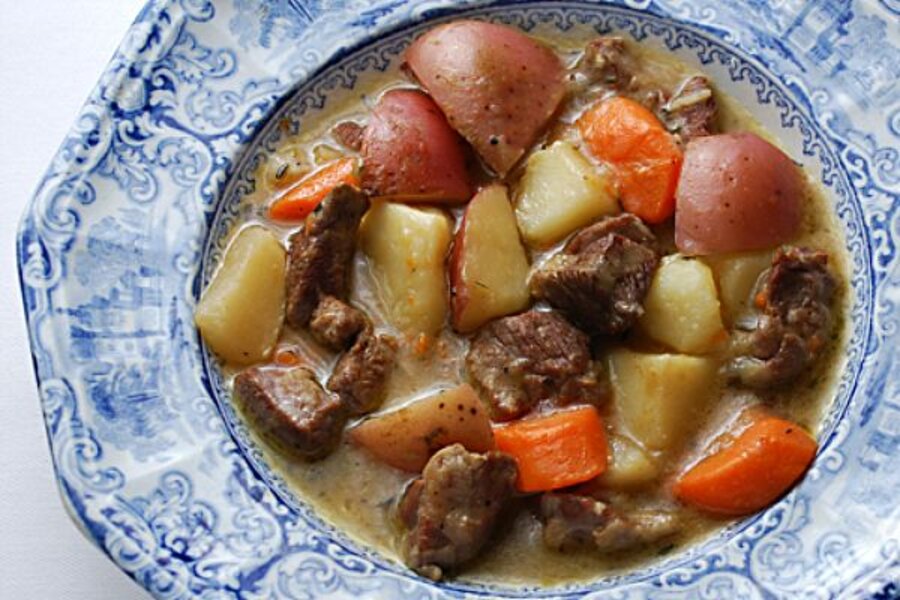Irish lamb stew
Loading...
Lamb stew is practically a national dish in Ireland and for good reason. Even the summers there aren’t what you’d call toasty, so a warm, stick-to-your-ribs dish like this is all the more welcome. And two key ingredients, lamb and potatoes, have been long associated with Ireland, both as crops and as staples. Surprisingly, though, ideas of what constitutes a traditional Irish lamb stew vary wildly. Some recipes call for browning the lamb, some not; different cooks add beer or wine or no booze at all; some add peas, some not; one recipe (which admitted to not being traditional) even added bacon. So after reading numerous recipes, both “Irish” and otherwise, I did what I usually do – I cobbled together my own take.
The distinctive taste of lamb. Throughout the UK and Ireland – indeed, throughout much of the Western world that isn’t the United States – lamb is much loved. Many Americans apparently have a hard time warming to what is often described as the gaminess of lamb. That gamy flavor – as the dictionary defines it, “having the tangy flavor or odor of game” – is what makes lamb special. It’s the same quality that separates venison from beef and duck from chicken. And while I love a good steak or roast chicken, there’s just something exciting about the “wildness” of game.
Lamb comes by its gamy character honestly. Their diet is more varied than most domestic animals, including not only grasses, but any other plants they come upon in their grazing. And they get more exercise, so their meat is more muscular and darker in color [thanks to improved circulation]. Together, these factors add up to lamb tasting closer to, say, deer or elk than to other domestic meats.
Much has been written about ways to tone down the gaminess of lamb. But I say embrace it. I mean, why bother to cook lamb if you just want it to taste like beef? In this delicious, simple stew, it adds a welcome distinctive touch that becomes more subtle as the stew cooks.
Lamb Stew
Serves 4
2 tablespoons canola oil (plus more, if needed)
1 tablespoon butter
1-1/4 pounds lamb, cut into bite-sized chunks (see Kitchen Notes)
Salt, freshly ground black pepper
1-1/2 teaspoons dried thyme, divided
1 medium yellow onion, chopped
2 cloves garlic, minced
2 tablespoons flour
1 bay leaf
12 ounces dark beer, such as a stout [can be omitted]
12 ounces chicken broth or stock
1 cup water (plus more, if needed)
1 turnip, peeled and cut into chunks
3 carrots, peeled and sliced on diagonal into bite-sized chunks
5 red potatoes, scrubbed and cut into bite-sized chunks, but not peeled (1-1/2 to 2 pounds)
For roux (optional):
1 tablespoon butter
1 tablespoon flour
Season lamb with salt, pepper and 1/2 teaspoon of dried thyme. In a dutch oven, heat canola oil and butter over medium-high flame, swirling to combine. Brown lamb in batches, 3 or 4 minutes per batch, transferring to a bowl as it is done. Reduce heat to medium and sauté onion until translucent, about 3 or 4 minutes, adding more oil if necessary. Add garlic and sauté until fragrant, about 45 seconds. Add flour and remaining thyme, stirring constantly until flour is slightly browned, about 2 minutes. Add beer and stir, scraping up any browned bits in pot. Stir in broth, water, turnip and carrots. Return meat to pot and bring to a boil. Reduce heat to very low, cover pot and simmer stew for 1/2 hour.
Add potatoes to pot and cook covered until potatoes are almost tender, about 1/2 hour, adding water by 1/4 cups, if necessary (it probably won't be). Uncover pot and continue cooking until lamb is tender, another 15 minutes or so. Meanwhile, check the sauce. It will probably be fairly soupy; some people prefer it this way. If you’d like your sauce a little thicker, make a quick roux. Heat a small skillet over a medium-low flame. Melt 1 tablespoon of butter and sprinkle in 1 tablespoon of flour, stirring with a whisk. Cook for 3 or 4 minutes, stirring constantly, until the mixture begins to brown. Add a scant 1/4 cup of water, stirring to blend. Stir resulting roux into stew pot and let it cook a few minutes longer. Adjust seasonings and serve immediately.
Kitchen Notes
Selecting lamb for stew. You can sometimes find lamb stew meat, pre-cut. If not, look for boneless lamb shoulder or bone-in lamb shoulder chops. If you opt for the chops, cut into chunks before cooking and trim away some of the excess fat (but don't go crazy here – a little fat adds flavor). Reserve the bones and brown with the meat, adding them back to the pot along with the browned lamb for added flavor. Remove bones before serving.
Terry Boyd blogs at Blue Kitchen.
To see the original post, click here.
--------------------------------------------------------------
The Christian Science Monitor has assembled a diverse group of food bloggers. Our guest bloggers are not employed or directed by The Monitor and the views expressed are the bloggers' own and they are responsible for the content of their blogs and their recipes. All readers are free to make ingredient substitutions to satisfy their dietary preferences, including not using wine (or substituting cooking wine) when a recipe calls for it. To contact us about a blogger, click here.





